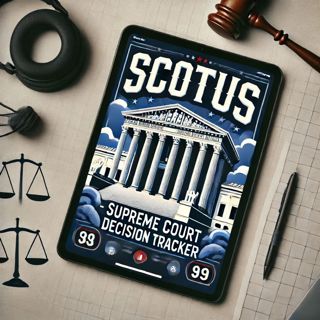
Supreme Court Rulings on Special Needs, IRS Accountability, and Criminal Justice
Hello and welcome to the SCOTUS News Tracker podcast. Here’s the latest from the US Supreme Court.On June 12, the Supreme Court issued several significant opinions. One notable case is *A.J.T. v. Osseo Area Schools, Independent School District No. 279*, which saw the court rule in favor of special-needs children in lawsuits against schools. This decision highlights the court's stance on the rights of students with disabilities under federal law.Another key decision was in *Commissioner of Internal Revenue v. Zuch*, where the court's ruling has sparked concerns about the IRS's accountability. Justice Gorsuch warned that the decision gives the IRS a powerful new tool to avoid accountability, indicating a potential shift in how the IRS operates.In the realm of criminal justice, the court decided cases such as *Rivers v. Guerrero*, *Martin v. United States*, *Parrish v. United States*, and *Soto v. United States*. These cases cover a range of issues, including procedural matters and the rights of inmates.Tensions among the justices have also been evident in recent decisions. For instance, in a case involving the removal of agency heads, Justice Kagan criticized the majority for what she saw as a politically motivated move. The majority's decision allowed the President to remove certain board members while specifically exempting the Federal Reserve, a move Kagan argued was unnecessary and reactive to current politics.Additionally, the court has been handling several emergency applications, including stays of execution. For example, in *Hoffman v. Westcott*, the court denied a stay of execution for Jessie Hoffman, despite dissents from Justices Sotomayor, Kagan, and Jackson.As the Supreme Court continues to navigate complex and contentious issues, the dynamics among the justices remain a focal point. The court's actions are closely watched, especially as they impact various aspects of American law and society.Thank you for listening to the SCOTUS News Tracker podcast. Don’t forget to subscribe for the latest updates and in-depth analysis of Supreme Court news.This content was created in partnership and with the help of Artificial Intelligence AI
16 Kesä 2min

"Supreme Court Delivers Rulings on Habeas Petitions, Sentencing, and Administrative Law"
The US Supreme Court has been active in recent days, with several significant developments.On June 12, the Supreme Court issued a decision in the case of Rivers v. Guerrero, which pertains to the timing and procedure of habeas petitions. This ruling clarifies the process once a district court enters its judgment on a first-filed habeas petition.In addition to this decision, the Supreme Court has added four new cases to its docket for the 2025-26 term. These cases, announced on June 6, involve critical issues such as federal sentencing, the death penalty, and civil procedure. One notable case is that of Joseph Smith, who was convicted and sentenced to death for murder. The justices had previously sent Smith’s case back to a federal appeals court to clarify whether executing him would violate the Eighth Amendment due to his intellectual disability.The announcement of these new cases was made earlier than scheduled due to a software malfunction that prematurely notified lawyers involved in the cases. Originally set for release on Monday morning, the list was instead released on Friday evening.Another recent development involves an executive order related to the Department of Government Efficiency (DOGE), which was addressed in a Supreme Court opinion on June 6. This opinion touches on significant administrative and privacy issues.These updates highlight the ongoing and diverse range of legal issues the Supreme Court is addressing, from procedural matters in habeas petitions to substantial questions on federal sentencing and administrative actions.Thank you for listening to the SCOTUS News Tracker podcast. Don't forget to subscribe for the latest updates on the US Supreme Court.This content was created in partnership and with the help of Artificial Intelligence AI
13 Kesä 2min

Supreme Court Decisions Favor Trump Administration's DOGE Amid Privacy Concerns
Hello and welcome to the SCOTUS News Tracker podcast. I'm Jason, your reporter for all the latest developments from the US Supreme Court.In recent days, the Supreme Court has made some significant decisions, particularly on its emergency docket. On Friday, the Court handed down two key rulings in favor of the Trump administration. The first decision allowed members of the Department of Government Efficiency, or DOGE, to access records from the Social Security Administration. This move was challenged by two labor unions and a grassroots advocacy group, who argued that granting DOGE access would compromise the privacy of personal data for millions of Americans.In the second decision, the Court temporarily paused an order from a federal judge in Washington, D.C., that would have required DOGE to provide information in a lawsuit filed under the Freedom of Information Act. Instead, the justices instructed the federal appeals court to re-examine the order with a more skeptical eye.These decisions come after President Donald Trump created DOGE through an executive order on the first day of his second term, aiming to modernize government technology and reduce waste and fraud.These rulings highlight the ongoing use of the Supreme Court's emergency docket, often referred to as the "shadow docket," which involves applications seeking immediate action from the Court.Thank you for listening to the SCOTUS News Tracker podcast. Don't forget to subscribe for the latest updates and analysis on the US Supreme Court.This content was created in partnership and with the help of Artificial Intelligence AI
11 Kesä 1min

Supreme Court Rulings: DOGE Access, Title VII Standard, and New Docket Cases
Hello and welcome to the SCOTUS News Tracker podcast. Here’s the latest from the US Supreme Court.On Friday, the Supreme Court handed down significant decisions in two cases related to the Department of Government Efficiency, or DOGE, which was created by an executive order from President Donald Trump on the first day of his second term. The court allowed DOGE to access records from the Social Security Administration, despite objections from labor unions and a grassroots advocacy group that argued this move compromised the privacy of personal data for millions of Americans. Additionally, the court temporarily paused a federal judge's order that required DOGE to provide information in a lawsuit filed under the Freedom of Information Act, sending the dispute back to a federal appeals court for further review.In another notable decision, the Supreme Court ruled on June 5th in the case of Ames v. Ohio Dept. of Youth Servs., where they rejected the "background circumstances" rule. This rule had imposed a heightened evidentiary standard on majority-group plaintiffs in Title VII cases. The court determined that Title VII does not require such a heightened standard, vacating the lower court's judgment and remanding the case for application of the proper prima facie standard.On the same day, the Supreme Court also added four new cases to its docket for the 2025-26 term. These cases involve a range of issues, including capital punishment, among others.The Supreme Court Building remains open to the public from 9 a.m. to 3 p.m., with Courtroom Lectures available for those interested.Thank you for listening to the SCOTUS News Tracker podcast. Don’t forget to subscribe for the latest updates and analysis on the US Supreme Court.This content was created in partnership and with the help of Artificial Intelligence AI
9 Kesä 2min

"Supreme Court Tackles Mail-In Ballot Dispute and Police Powers in New Cases"
In the latest developments from the US Supreme Court, the justices have added four new cases to their docket for the 2025-26 term. One of the notable cases is _Bost v. Illinois State Board of Elections_, which involves a challenge to Illinois’s procedures for counting mail-in ballots. The lawsuit, filed by Congressman Michael Bost and two presidential electors, argues that the state's laws allowing election officials to count mail-in ballots received up to two weeks after Election Day, as long as they are postmarked by that date, violate federal law and the Constitution.Another significant case added to the docket pertains to the extent of police officers’ ability to enter one’s home under the Fourth Amendment, highlighting ongoing debates about law enforcement powers and individual rights.In addition to these new cases, the Supreme Court has also made decisions on several other matters. The justices denied review in several cases, including two challenges to gun-control measures in Rhode Island and Maryland. This decision indicates that the current gun-control laws in these states will remain in place, at least for the time being.On the decisions front, the Court has recently issued opinions in various cases. For instance, the Court ruled on _Seven County Infrastructure Coalition v. Eagle County_, involving a proposal to construct an 88-mile railroad line in Utah's Uinta Basin. Other recent decisions include _OK Charter School Board v. Drummond_ and _Kousisis v. United States_, which dealt with different legal issues such as charter school governance and federal contracting regulations.These recent actions and decisions reflect the Court's ongoing role in shaping legal precedents and addressing critical issues in the United States.Thank you for listening to the SCOTUS News Tracker podcast. Don't forget to subscribe for the latest updates and in-depth analysis on Supreme Court news.This content was created in partnership and with the help of Artificial Intelligence AI
4 Kesä 2min

Supreme Court Grapples with Nationwide Injunctions and Executive Power in Upcoming Decisions
As we approach the end of the Supreme Court's term, several significant cases are still awaiting decisions, and recent developments have been noteworthy.One of the major cases on the horizon is Trump v. CASA, which revolves around the issue of nationwide injunctions rather than the specifics of Trump’s executive order on birthright citizenship. The Supreme Court is considering whether lower courts can issue universal injunctions that block policy implementations nationwide. Oral arguments took place on May 15, with several justices expressing frustration with these types of injunctions. The ruling could have far-reaching implications for future administrations, as it may set a precedent on the scope of judicial power to halt executive actions.In recent decisions, the Supreme Court has handed down rulings on various cases. On May 22, the court issued a decision in OK Charter School Board v. Drummond, where the judgment was affirmed by an equally divided Court. Another notable case is Kousisis v. United States, decided on the same day, which involved federal regulations and subcontracting requirements for painting projects in Philadelphia.Additionally, the court ruled on A.A.R.P. v. Trump on May 16, where the President's invocation of the Alien Enemies Act to remove Venezuelan nationals was at issue. This case highlights the ongoing debates around executive power and national security.The Supreme Court is set to release more decisions in the coming weeks, with the next decision day scheduled for June 5. This period will be crucial as the court addresses other pressing issues, including transgender rights and LGBTQ+ pedagogy, which are among the remaining high-profile cases.Thank you for listening to the SCOTUS News Tracker podcast. Don't forget to subscribe for the latest updates and in-depth analysis on Supreme Court news.This content was created in partnership and with the help of Artificial Intelligence AI
2 Kesä 2min

"Pivotal Supreme Court Rulings: From Education to Immigration, Policing Decisions Reshape Legal Landscape"
As of the latest updates, the US Supreme Court has been engaged in several significant activities and has issued notable decisions.Recently, on May 22, 2025, the Supreme Court released opinions in two important cases. The first case, OK Charter School Board v. Drummond, was decided on this date, although the specifics of the ruling are not detailed here. Another significant decision was in Kousisis v. United States, involving contracts awarded by the Pennsylvania Department of Transportation and federal regulations on subcontracting.Earlier, on May 16, 2025, the Court issued a decision in A.A.R.P. v. Trump, where the President had invoked the Alien Enemies Act to remove Venezuelan nationals identified as members of a designated foreign terrorist organization. This case highlighted issues related to immigration and national security.On May 15, 2025, the Court decided Barnes v. Felix, a case involving a law enforcement officer who fatally shot a suspect during a traffic stop. This decision addressed critical issues related to police use of force.In addition to these decisions, the Supreme Court has been considering several high-profile applications for stays. Notably, the Trump administration has been seeking a stay to allow deportations to third-party countries. This matter was set for oral argument on May 15, 2025, and involves consolidated applications that were deferred pending this argument.These developments underscore the active and complex landscape of the US Supreme Court, with ongoing deliberations and recent rulings that have significant implications for various aspects of law and policy.Thank you for listening to the SCOTUS News Tracker podcast. Don't forget to subscribe for the latest updates and in-depth analysis on the US Supreme Court.This content was created in partnership and with the help of Artificial Intelligence AI
30 Touko 2min

Supreme Court Decisions: Educational, Contractual, and National Security Implications
In the latest developments from the US Supreme Court, several significant decisions and events have captured attention. On May 22, 2025, the Supreme Court issued two notable rulings. The first case, OK Charter School Board v. Drummond, resulted in a judgment being affirmed by an equally divided Court, highlighting the split decision among the justices.Also on May 22, the Court decided Kousisis v. United States. This case involved Stamatios Kousisis and Alpha Painting and Construction Co., which were awarded contracts by the Pennsylvania Department of Transportation. The decision centered around federal regulations and subcontracting requirements, providing clarity on compliance with these regulations.Another recent decision came on May 16, 2025, in A.A.R.P. v. Trump. Here, the Court addressed the President's invocation of the Alien Enemies Act to remove Venezuelan nationals identified as members of a designated foreign terrorist organization. This case delved into the legal implications of such actions and the rights of detainees.Additionally, on May 15, 2025, the Court ruled in Barnes v. Felix, a case involving a law enforcement officer who fatally shot a suspect during a traffic stop. The decision in this case has significant implications for police use of force and the legal standards governing such actions.These recent decisions reflect the Supreme Court's ongoing role in shaping key aspects of U.S. law, from educational and contractual matters to national security and law enforcement practices.Thank you for listening to the SCOTUS News Tracker podcast. Don't forget to subscribe for the latest updates and in-depth analysis on U.S. Supreme Court news.This content was created in partnership and with the help of Artificial Intelligence AI
28 Touko 2min




















